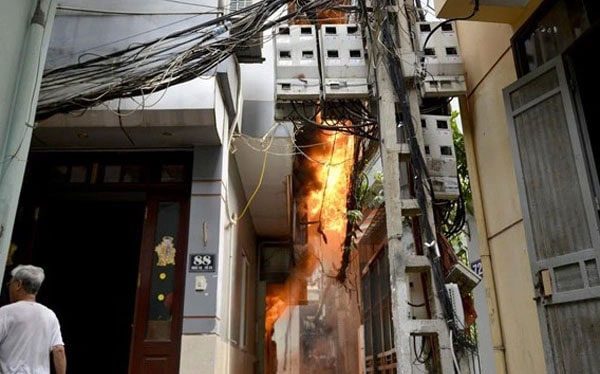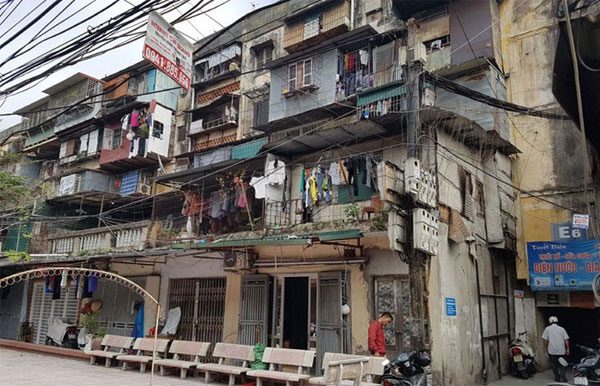Those trapped inside panic, wanting to escape, while those outside feel helpless and unable to help. Why aren’t we better prepared to minimize casualties when “the fire” can strike unexpectedly?
As of early 2022, numerous significant fires have occurred, resulting in casualties and property loss. The primary causes have been identified as electrical equipment failures and negligence in handling fire sources. To effectively prevent fires and explosions, the public must understand the causes of fires, how to respond, and escape strategies in such situations.

A fire occurs in a deep alley.
Potential Fire Hazards in Your Home
Electrical Equipment
According to statistics from the Fire Prevention and Rescue Police Department, as of the end of the first quarter of 2022, there were 140 fire incidents in the country (accounting for 31.6%) due to electrical system and equipment failures. Most of these incidents were caused by electrical overload leading to short circuits.
As we enter the peak heat season, the demand for electricity will rise significantly, with cooling devices operating at high capacity. Consequently, it is not uncommon for 2-3 fires to occur in a single day.
Households Combined with Businesses
In Vietnam, many households utilize the first and second floors of their homes for business purposes: grocery stores, furniture shops, bars, etc. In the short term, combining residential space with business can save on rental costs. However, looking further ahead, if a fire occurs in these types of businesses, the consequences can be severe.
For business purposes, the lower floors tend to be filled with furniture, tables, goods, and other items that are highly flammable. Fires can spread rapidly in such environments.
House Design
In Hanoi, Ho Chi Minh City, and other major cities, it is common to see high-rise narrow houses closely packed together, or old apartment buildings. Residents often install iron bars on balconies and windows for protection. Additionally, there are “specialty” deep alleys with pathways less than one meter wide. In most cases, these types of houses typically have only one escape route: the main door.

Old apartment buildings pose high fire risks but are hard to escape from.
If fire engulfs this only escape route, will residents choose to jump out or wait for rescue? For houses located at the end of small alleys, fire trucks cannot access them easily, complicating rescue efforts. By the time water hoses can be brought from outside, the fire may have already destroyed most of the property. Houses that are closely adjacent also face a high risk of fire spread.
If the house cannot be changed, what should be done when disaster strikes?
Some Fire Prevention Measures and Escape Strategies
Equip Yourself with Knowledge and Skills
Having solid knowledge of fire prevention and escape techniques will help residents remain calm during emergencies. Participating in local training sessions will greatly assist in rescue efforts, thereby reducing casualties for both residents and firefighters.

Fire prevention training in the community.
Essential Equipment
Fire Alarms: Fire alarms operate continuously 24 hours a day. When detecting sudden increases in temperature, smoke, fire, or gas, the device emits signals (alarms and lights) to alert individuals, allowing for timely intervention to prevent fire incidents.
Fire Extinguishers: There are three types of fire extinguishers: powder, foam, and gas. When a small fire is detected, residents should immediately use an extinguisher to put out the flames. In cases where the fire is too large to extinguish with a fire extinguisher, it can be used to help open an escape route. Extinguishers should be placed in easily accessible locations: kitchens, stairways, etc.
Escape Devices: There are two common types of escape devices: rope ladders and automatic escape harnesses.
Rope Ladders: These devices are designed to withstand weight and high temperatures. When escaping, users must climb down the ladder to reach the ground safely. The time taken for each escape depends on the speed of the individual. For elderly people, children, or those afraid of heights, using a rope ladder may not be feasible.
Automatic Escape Harness: This cable is designed to bear weight and withstand temperatures of up to 1000 degrees Celsius. The device is usually installed in fixed locations such as balconies, windows, or rooftops, ensuring users do not panic while looking for an escape route.

The automatic escape harness is easier to use than a rope ladder.
Simply fasten the secure safety harness to your body, and then gradually lower yourself outside. Users do not need to adjust their speed or possess any special skills; the escape harness will safely lower you to the ground in under a minute. This safety device is suitable for elderly individuals, women, and children. The product has been certified for safety by the Hanoi Fire Prevention Police Department.
To achieve high effectiveness in fire prevention, it is crucial to choose a reputable supplier for escape equipment. Residents need to wisely select genuine products to ensure quality and safety for users.


















































